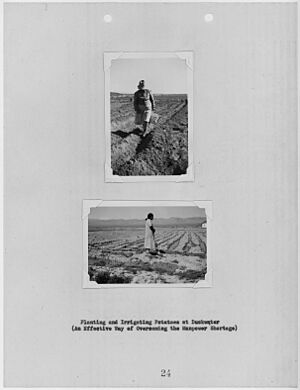Duckwater Shoshone Tribe of the Duckwater Reservation facts for kids

Haymaking at Duckwater Reservation in the 1930s
|
|
| Total population | |
|---|---|
| ~288 | |
| Regions with significant populations | |
| Languages | |
| English, Shoshone | |
| Religion | |
| Traditional tribal religion | |
| Related ethnic groups | |
| Other Western Shoshone tribes |
The Duckwater Shoshone Tribe is a Native American tribe. They are a recognized tribe of the Western Shoshone people. They live in central Nevada, in a desert area called Railroad Valley. Their own name for themselves is Tsaidüka. This means "Eaters of tule" in their Shoshone language. Tule is a type of plant.
In 2016, the tribe received more land for their reservation. About 31,269 acres (126.5 km²) of land were added. This land is managed by the Bureau of Land Management (BLM). It helps the tribe have a more stable future. No gambling is allowed on these new lands.
Contents
Where the Duckwater Shoshone Live
The Duckwater Shoshone Tribe has its own special land. This land is called the Duckwater Reservation. It is located in Nye County, Nevada. The reservation was started in 1940. At that time, the tribe bought a ranch that was 3,272 acres (13.2 km²). Twenty-one families moved onto this land.
Today, the reservation is about 3,815 acres (15.4 km²) in size. In 1990, about 288 tribal members lived there. In 2016, the government added about 31,269 acres (126.5 km²) more land. This was done to help the tribe grow.
A Look at Duckwater Shoshone History
Long ago, the Shoshone people were part of the Great Basin tribe. They hunted near Railroad Valley in the summer. In winter, they lived in cone-shaped homes in the mountains. They hunted ducks, sage grouse, rabbits, and deer. They also gathered plants like chenopodium.
In the late 1800s, settlers from Europe and America came to their lands. A peace agreement, the 1863 Treaty of Ruby Valley, was made. It said that no more settlers would come. It also said the Shoshone did not give up their land. Many tribal members found work on ranches.
The tribe set up a new government in 1934. This was done under the Indian Reorganization Act.
Life for the Tribe Today
The Duckwater Shoshone Tribe's main office is in Duckwater, Nevada. A tribal council with five members leads the tribe. They are chosen in elections each year. The tribe has offices for health and a police department. They also have a center for older tribal members.
The Duckwater-Shoshone Nursery is a business run by the tribe. They grow native plants in greenhouses. These plants help clean up land after mining. The tribe has also received money to help save a fish called the Railroad Valley springfish. This fish is a threatened species.
Every June, the tribe holds its annual Duckwater Festival. It includes a powwow, a barbecue, and traditional handgames. This festival continues old traditions. It is a time when the tribe celebrates together.
Learning and Education
There is a school on the reservation called Duckwater Shoshone School. It teaches students from kindergarten to 8th grade. The school was started around 1973. Tribal members wanted a better education for their children. The school building used to be a church.
In 1975, there were 21 students at the school. The school was updated in 1982. It even has its own small zoo!
Some students from the Duckwater area also go to other high schools. These schools are in Eureka, Lund, and Ely. Sometimes, students live with local families in these towns while they attend high school.
Important Tribal Members
- Tina Manning (died 1979), she worked to protect water rights for the tribe.




